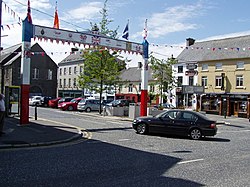Rathfriland
| Rathfriland | |
| County Down | |
|---|---|
 Church Square Rathfriland | |
| Location | |
| Location: | 54°14’17"N, 6°9’40"W |
| Data | |
| Population: | 2,740 (2001) |
| Post town: | Newry |
| Postcode: | BT34 |
| Dialling code: | 028 |
| Local Government | |
| Council: | Armagh, Banbridge and Craigavon |
| Parliamentary constituency: |
South Down |
Rathfriland is a confident village in County Down, on a hilltop on the north edge of the Mourne Mountains, between the bulk of those mountains, Slieve Croob and Banbridge. It had a population of 2,740 people recorded in the 2011 Census.
The village was founded at the Plantation of Ulster in the early seventeenth century. Its name is from the Irish Ráth Fraoileann, meaning "Ringfort of Fraoile".[1]
Churches
The following churches are located in the town and several more are found in the surrounding countryside:
- Church of Ireland: St. John's
- Baptist: Rathfriland Baptist Church
- Pentecostal: Elim Pentecostal Church
- Presbyterian:
- 1st Rathfriland Presbyterian Church
- 2nd Rathfriland Presbyterian Church
- 3rd Rathfriland Presbyterian Church
- Reformed Presbyterian (Covenanters): Rathfriland Reformed Presbyterian Church
- Roman Catholic: St Mary's
All local Protestant churches are strongly evangelical.
History

In older English documents, the village's name was usually spelt Rathfylan or Rathfrilan.[2] It was once the capital of the Magennis family. The ruins of an old castle may still be seen on the hill upon which Rathfriland sits. It was a square building of 3-4 storeys with a stone barrel vault at the ground floor to lessen the risk of fire. The castle was once much bigger but most of it was pulled-down by Mr William Hawkins of London, the first Protestant proprietor there after the rebellion of 1641, and the rest destroyed by General Ireton on Oliver Cromwell's orders. The stones were used to build the Town Inn (the building of which still stands on the corner of The Square and Newry Street) and other houses in the village. In 1760 the Market House, which dominates the main square, was built for the linen market by Miss Theodosia McGill. An old map of 1776 prepared for the Meade Estate shows streets, lanes, tenements and gardens forming the early village.
A clock-faced war memorial stands in the square on the south-eastern side. To this day, the names Meade, Maginess and Hawkins live on in Rathfriland, most notably in Iveagh Primary School where the three surnames are the name of the 'houses' or teams on sports day.
The "Battle of Dolly's Brae" took between Rathfriland and the nearby town of Castlewellan on 12 July 1849. Up to 1,400 Orangemen marched from Rathfriland to Tollymore Park near Castlewellan. When 1,000 barely armed Ribbonmen gathered, rocks were thrown at the Orange parade. Roman Catholic homes were burned and 80 Roman Catholics killed.[3]
Rathfriland lies in the county of Down, the Baronies of Iveagh Lower, Lower Half and Iveagh Upper, Upper Half, the townlands of Rossconor and Lessize, the district electoral area of Knockiveagh, and the civil parishes of Drumballyroney and Drumgath.
Transport
Rathfriland was served by Ballyroney Railway Station, three miles away. Goods and passengers were transported from the station to the village. The former GNR (I) line between Banbridge and Newcastle was shut down in 1955.
Sport
- Football:
- Rathfriland Rangers FC
- Rathfriland Junior FC
- Bowling: Rathfriland Bowling Club
- Angling: Rathfriland Angling Club - game fishing on the Upper River Bann and Drumlough Lake.
Media
- The Outlook (village newspaper, since 1940)
Outside links
| ("Wikimedia Commons" has material about Rathfriland) |
References
- ↑ Toner,G Ó Mainnín, M (1992). Place-Names of Northern Ireland Volume One. County Down I. Newry and South-West Down, p.126. The Northern Ireland Place-Name Project, Department of Celtic, The Queen's University of Belfast, Belfast. ISBN 0-8538-9432-9
- ↑ Placenames Database of Ireland: Rathfriland/Ráth Fraoileann (see archival records)
- ↑ "Parades and Marches - Chronology 2: Historical Dates and Events". Conflict Archive on the Internet (CAIN). http://cain.ulst.ac.uk/issues/parade/chpa2.htm. Retrieved 16 April 2014.
